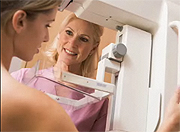Radiation dose from screening mammogram found to be up to 35 percent lower than previously believed
WEDNESDAY, July 15, 2015 (HealthDay News) — The low risks from radiation exposure during mammography screening may be even lower than experts have assumed, a new study contends. The findings were scheduled for presentation Wednesday at the annual meeting of the American Association of Physicists in Medicine, held from July 12 to 16 in Anaheim, Calif.
Andrew Hernandez, a Ph.D. candidate at the University of California, Davis, and colleagues created a model of breast anatomy based on computed tomography scans from 219 women — who varied in age, ethnicity, and breast density.
By focusing on the radiation dose deposited only to the glandular tissue, the new research estimates that the radiation dose from a screening mammogram is anywhere from 20 to 35 percent lower than previously thought.
“The decision to screen is a computation based both on benefit and risk. We know what the benefits are, and our research now suggests that the risk of developing cancer from screening mammography is 30 percent lower than previously thought,” Hernandez said in a news release from the American Association of Physicists in Medicine. “The next step is to update the radiation dose methods relevant to mammography to reflect the real distribution of glandular tissue.”
Copyright © 2015 HealthDay. All rights reserved.








